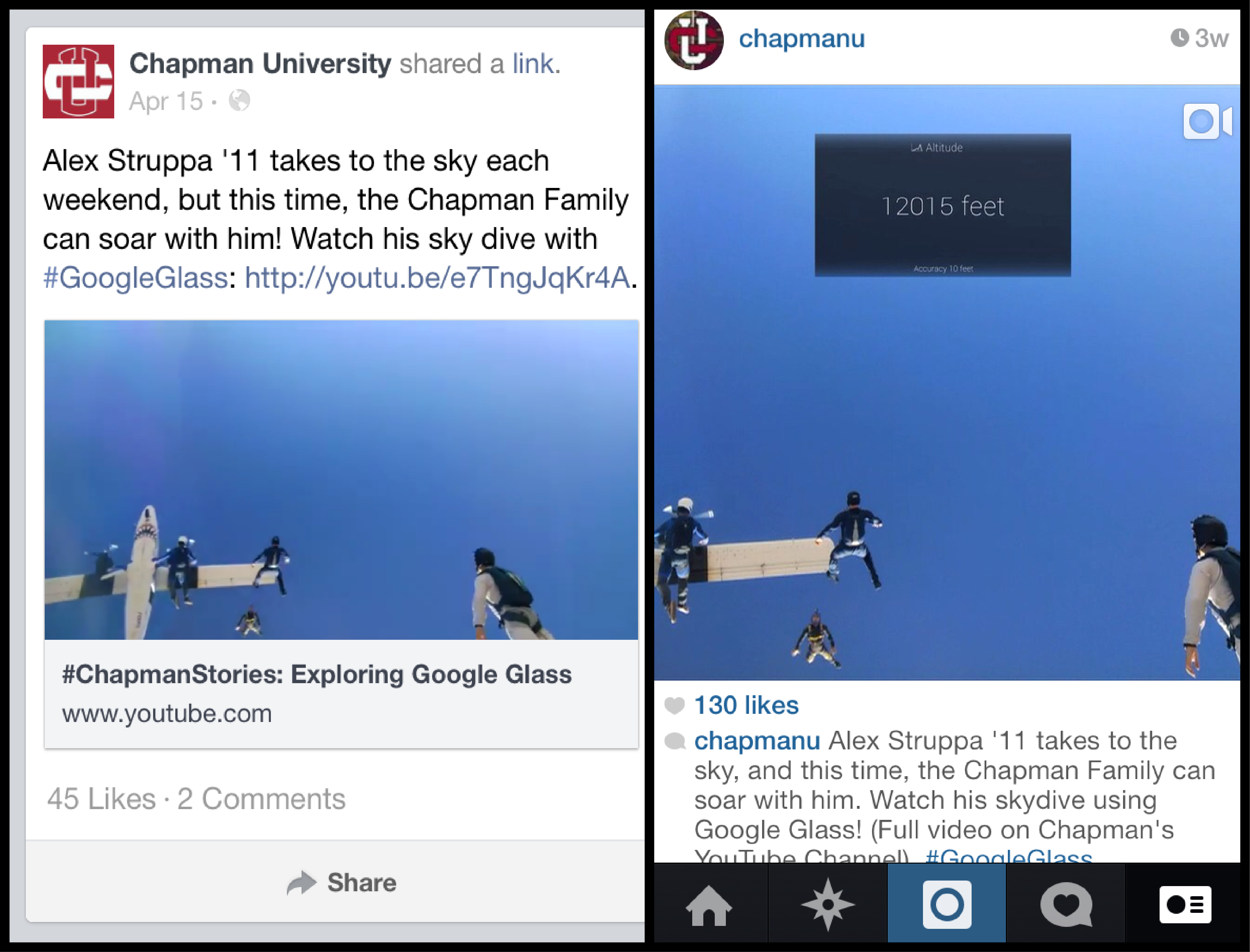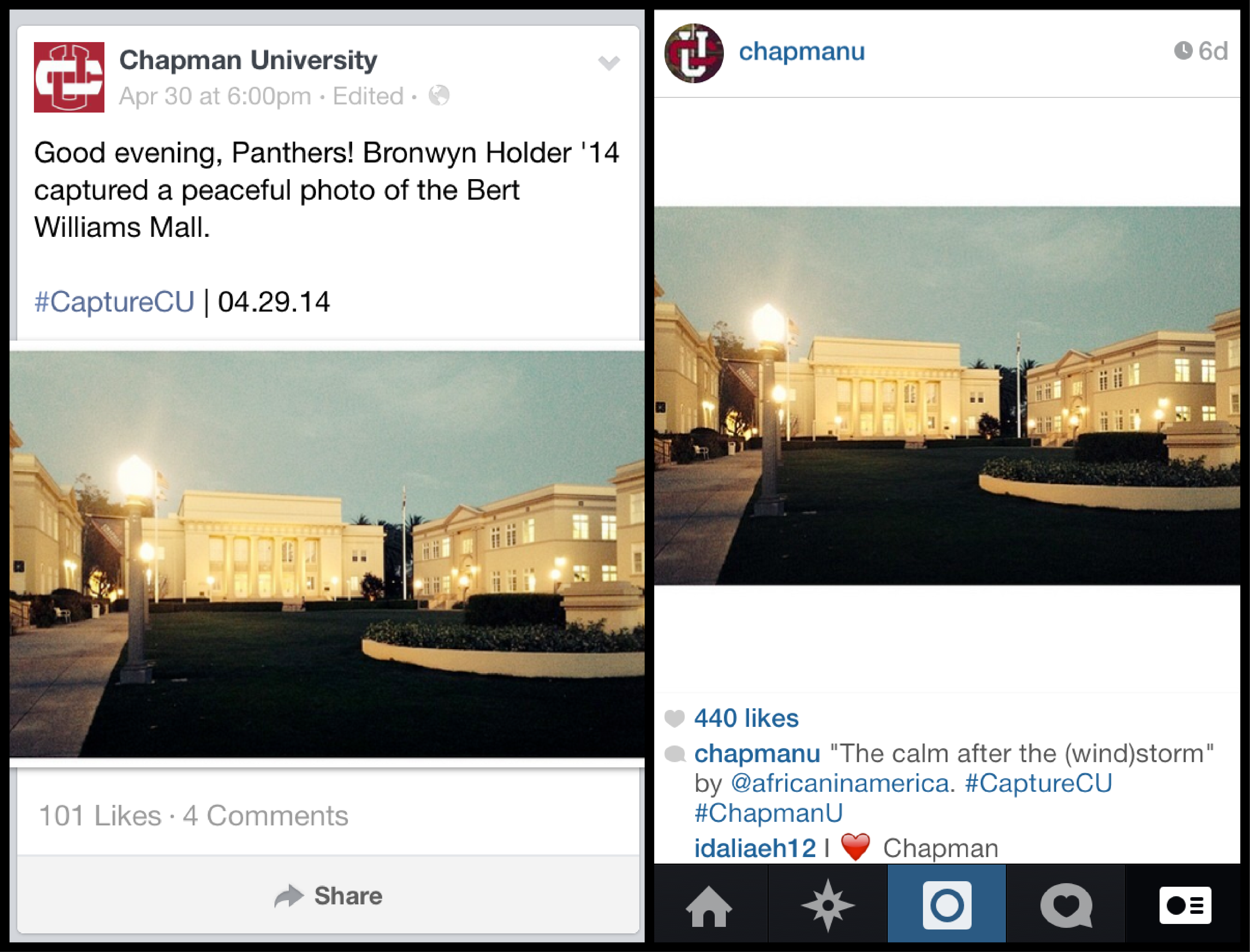Facebook vs Instagram: let’s compare – or not
May 2, 2014
Last week, articles across the Internet read: ”
For Your Next Social Media Campaign, Look to Instagram
“; ”
Instagram Is a Marketer’s Best Friend – For Now
“; and ”
Instagram’s Sweet Spot: Better for Brands than Facebook and Twitter?
” Social media marketers have noticed a decline in reach on Facebook and heightened engagement on Instagram.
Instagram is quickly becoming the best platform for “marketers to interact with consumers” and research shows the app is boasting roughly 60 times higher engagement than papa Facebook. I have seen the difference for myself. While photos of Chapman University’s campus are widely popular across all social media channels, our engagement numbers on Instagram are sky high. Out of curiosity, I did an A/B test to examine the differences in interaction levels for the same photos on Facebook and Instagram.
But let’s not freak out.
In my opinion, the numbers on Instagram are as they should be. Inc.’s article even states: “… companies can expect a much higher rate of engagement with customers on Instagram than on other popular social sites.” Keyword: expect. Brands should expect higher engagement numbers because Instagram was built for users to engage. The same could be said for Facebook, but the focus and design is drastically different.
A community of #Instagrammers.
Hashtags like #instagood, #instagrammers, and #instadaily are used to connect a community of users: a community of (amateur) photographers and curators. Unlike Facebook, this community chronicles their
hobbies
and
interests
through photographs.
Personally, I’m more interested in
seeing
your walk in Central Park than reading your check-in. I’m also more likely to scroll, pause, and like your “walk in Central Park” because I’m emotionally connected and stimulated by the image. Instagram provides a playground for photos: a playground easily accessible, unobtrusive, and inviting.
Instagram’s sweet spot? The absence of clutter.
I believe Instagram was built for the modern-day user. It’s an intimate mobile-only application that creates space for engagement. It’s simplicity actually makes it hard not to engage. See: photo. Select: Like. Consider: Comment. Move on. Users can easily scroll – engaging or dismissing – as they please.
Context is in the picture.
I do not think our old friend Facebook is in the business of pictures. Facebook is a profile: a place to host your information, your photos, your resume, your activities and locations, and your thoughts and musings. Facebook is all about identity, placing emphasis on text first, image second. In comparison, Instagram is image first, text second.
The call to action order is different. Because Facebook allows for a variety of content, it wants context. (Hint, hint: advertising!) The more you describe your photos, work and education history, activities, and interests, the better Facebook “understands you.” And the more they understand you, the more you’ll see particular posts (which unfortunately affects brands).

If you’re on Instagram, you’re interested in engaging. Scroll, like. Scroll, like. Repeat. Of course Instagram’s engagement numbers are going to be higher:
- Engagement and user options are limited: limit the options and watch the numbers grow.
- Remixing others’ content and sharing it is limited: people are unafraid to engage because it will not connect or appear on their profile.
- Facebook filters brands based on the life you live online.
- Facebook presents a variety of content, spreading engagement numbers thin.
The child becomes the parent.
Forrester Research, Inc. collected data that people, in general, don’t interact with branded content on a regular or semi-regular business. I’m not surprised. I, too, get tired of branded content in my Newsfeeds and Timelines.
Instagram is setting an example for others. Vine and Snapchat also provide easy-to-use, visually-stimulating environments for communities of people. But that’s just not Facebook.
Am I happy with Facebook? No, not at all. Will I continue to invest? For now. Will I heighten my activity on Instagram? Probably.
Yes, it is arguably time to reinvent some social media strategies but Facebook and Instagram are two very different ways to tell your story. You must 1) determine if it’s worthwhile to create a companion narrative (link, photo, video) to be successful on Facebook … or 2) determine if a simple photo is all that’s needed to keep your community engaged. And if it is a photo, then you have your answer.
Connect with @SheriLehman and the Chapman social media community. Featured image by Jason Howie via flickr.


